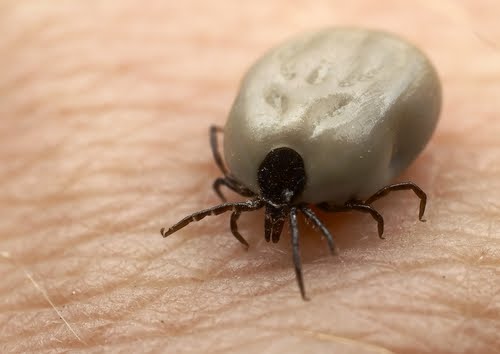Experts warn of increases in tick-borne Powassan virus
http://www.cnn.com/2017/05/03/- Anyone bitten by an infected tick is susceptible to the rare virus
- The virus can be fatal in up to 15% of cases with symptoms, one doctor warns
(CNN) Summer
is nearly here, & it's bringing fears of a rare tick-borne disease
called Powassan. This potentially life-threatening virus is carried &
transmitted by 3 types of ticks, including deer tick that
transmits Lyme disease.
Over
past decade, 75 cases were reported in northeastern states &
Great Lakes region.
Warmer winters result in increases in the tick
population, so experts predict rising tick-borne infections of many
types.
Everyone
is at risk for Powassan. Infections are most likely during late spring, early summer
&
mid-fall, when ticks are most active.
About
15% of patients who are infected & have symptoms are not going
survive. Of survivors, at least 50% will have
long-term neurological damage that is not going to resolve."
Although
most infected people will never show symptoms, those who do become sick
usually do so a few days to about a week after tick bite.
The most common symptoms will be fever & headache.
The
unlucky few who develop a more serious illness will do so very quickly
over next couple of days. You start to develop
difficulties with maintaining your consciousness & your cognition. ...
You may develop seizures. You may develop inability to breathe on your
own.
Just as there are no vaccines to prevent infection, there are also no treatments for Powassan.
Standard treatment includes intravenous fluids, though antiviral medications, systemic corticosteroids & other drugs have been tried in some patients. Scientists
also believe Powassan is on rise based on studies that have
identified an increasing number of infections in deer.
There are more & more deer that they're finding
that have been infected with this virus.
Similarly, Lyme is showing increasing numbers.
Prevention is first step
The Powassan virus was first discovered in Ontario in 1958. A child came down with an unspecified encephalitis," or brain inflammation. When the never-seen-before virus was identified,
scientists called it Powassan after town where child lived.
Dr.
Daniel Pastula, an assistant professor of neurology, medicine
(infectious diseases) & epidemiology at University of Colorado
Denver & Colorado School of Public Health, explains that of 3 ticks
that can carry Powassan -- Ixodes cookei, Ixodes marxi & Ixodes
scapularis -- the third "likes to bite humans" the most.
Commonly known as a deer tick, Ixodes scapularis can also bite mice, Pastula explained.
"The
thought is maybe that is where it gets Powassan from," he said. The
virus may enter cycle between ticks & small & medium-size forest
rodents that live up in Great Lakes & Northeast, & "humans just
happen to be occasionally involved in that cycle."
"Unless you're an entomologist, it's very hard to identify ticks. They're kind of small," he said.
"The
best thing people can do if they're worried about Powassan or any other
tick-borne virus is to prevent against all tick bites," Pastula said.
This
is best done by avoiding high brushy areas whenever you're in the
woods, wearing long sleeves & pants when feasible, using insect
repellent & doing tick checks after being outdoors, he said.
"It
has to be insect repellent that is actually shown to work. Repellents containing
DEET or picaridin or IR3535 are recommended ones, according to EPA & CDC," Pastula said.
"Essentially, you don't need to worry about Powassan if you don't get bit by a tick," he said.

No comments:
Post a Comment